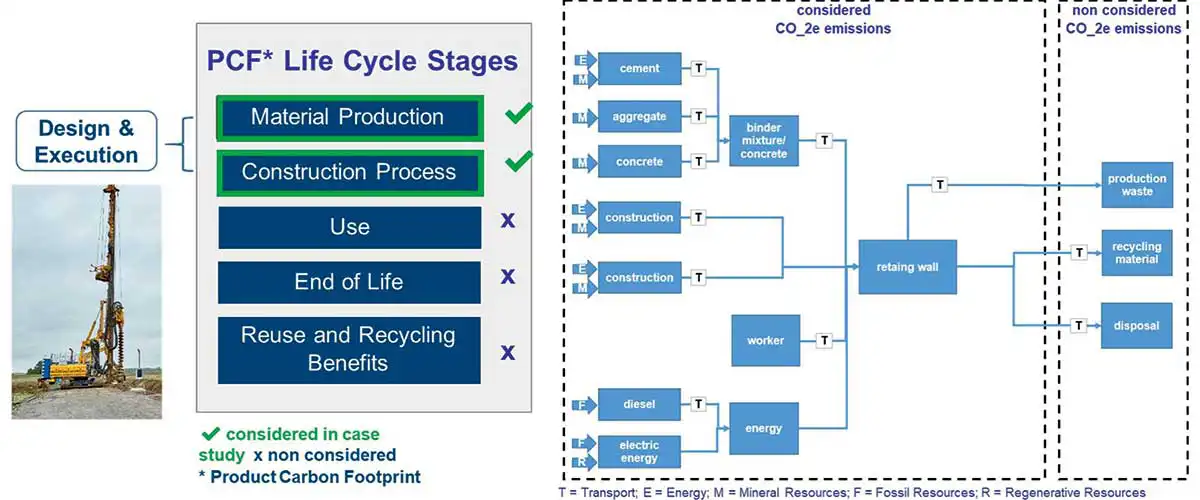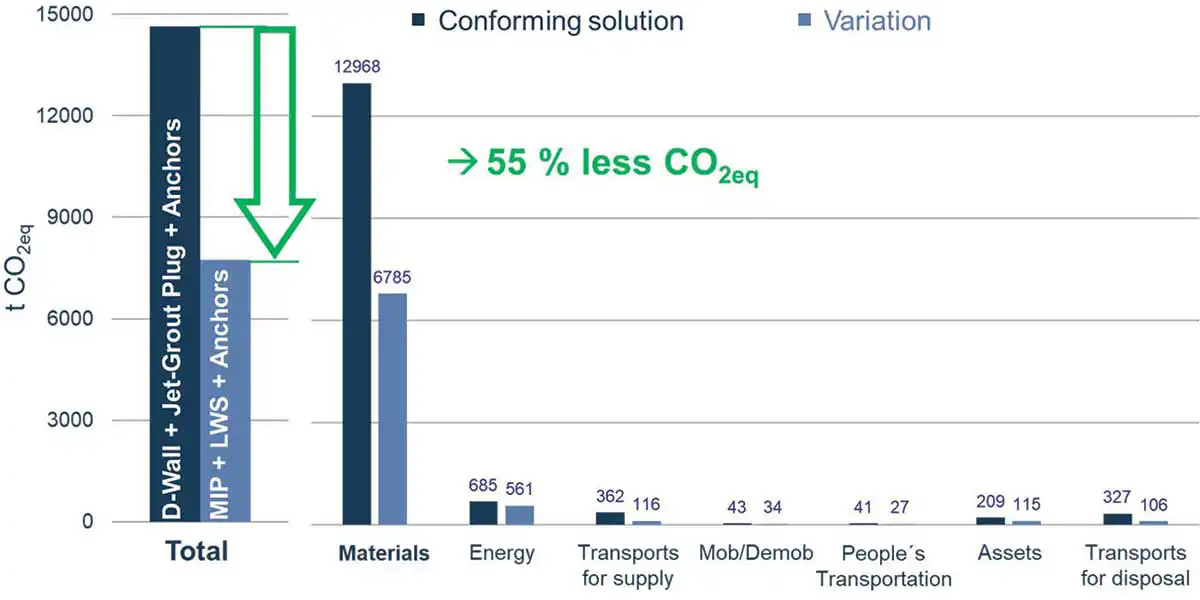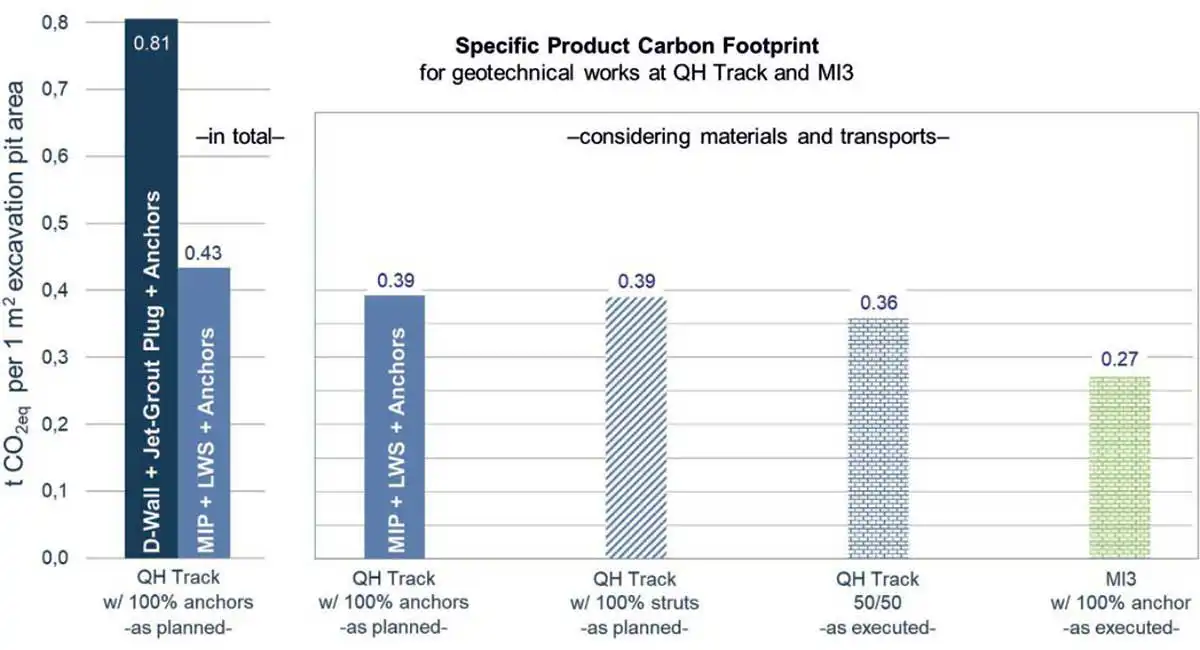Sustainability in Construction Industry
Sustainable products for geotechnical works are those that may cause less emissions and increase the sustainability of construction activities. The key parameter to sustainable products for geotechnical works is the optimisation of processes on site needed to fulfill the client’s building task, including the selection of technologies and construction methods with minimum environmental impact and minimum carbon footprint.
Florian Bauer and Karsten Beckhaus, Members of the Management Board, and Marcus Daubner, Head – Digitalisation, BAUER Spezialtiefbau GmbH, Germany.
The construction industry can and needs to contribute to a more sustainable world. Site traffic is overstraining the world’s big towns and cities. The sealing of areas continues to consume the natural environment required for global climate preservation. Each decision taken for a structure affects the carbon footprint and general sustainability. Cooperation based on partnership for working together effectively and unobstructed is required to construct a sustainable structure. The United Nations Sustainable Development Goals (SDG’s) include ecological, economic and social aspects, some with particular relevance for geotechnical works (figure 1).
 Figure 1: Specific SDG’s and postulated targets of the UN, with relevance for geotechnical works
Figure 1: Specific SDG’s and postulated targets of the UN, with relevance for geotechnical works
Bauer Spezialtiefbau examines and evaluates the potential for sustainability in the specialist foundation industry in the in-house Working Group referred to as “Product Sustainability”, on an international level while aiming for a normalized and a “harmonized” system. Several tangible fields of activity have been identified and are prioritised to continuously develop from a basic idea to an in-house state of the art.
With regards to geothermal activation, deep soil mixing is deemed an ideal execution method, due to the beneficial heat transfer from soil to the geothermal probes when fixed to the structural steel beams installed. This idea is part of a patent granted to Bauer Spezialtiefbau. For a project in the city of Füssen, Germany, a dwelling with 14 housing units, involving the construction of Mixed-In-Place (MIP) retaining walls, 1 kW of electricity was successfully used to generate 5.5 kW of heat. Figure 2 shows the schematic function as well as pictures from the execution of this particular kind of pilot project for which Bauer won the innovation award of the Bavarian construction industry association in 2019.
 Figure 2: Application of geotechnical elements to activate geothermal energy for buildings, with geothermal probes attached to steel beams ready for installation into the MIP wall for a dwelling in Füssen, Germany.
Figure 2: Application of geotechnical elements to activate geothermal energy for buildings, with geothermal probes attached to steel beams ready for installation into the MIP wall for a dwelling in Füssen, Germany.
Apart from geothermally activated foundation elements, geothermal heat can also be used directly: As part of a large investment program, BAUER Foundations Philippines, Inc was commissioned to carry out geothermal bores for a geothermal power plant in the Philippines. Multiple bore holes with a diameter of 1,200mm are constructed to depths upto 150m.
 Figure 3: Product Carbon footprint calculation process considered for geotechnical works
Figure 3: Product Carbon footprint calculation process considered for geotechnical works
It has been proven again that the major advantage of the Mixed-in-Place technology is to save material and reduce transports. The other variation was to replace the conforming jet-grout plug by a silicate gel grout plug which is another great factor to reduce the carbon footprint for QH Track, by leaving the soil in place and only filling the pores, thus using less material and producing no backflow for disposal.
The graph in Figure 4 shows that replacing the conforming solutions, i.e. diaphragm wall and horizontal jet-grout plug, can save more than 50% of CO2eq emissions, by the variation of MIP retaining wall and silicate gel permeation grout plug to cut off the excavation pit from ground water. It further reveals that emissions are predominantly saved due to less material consumption, followed by substantial savings of >100 tCO2eq due to energy consumption and transports for supply and disposal. For both solutions, ground anchors were considered for tie-back at this stage.
 Figure 4: CO2eq balances for the geotechnical works at QH Track
Figure 4: CO2eq balances for the geotechnical works at QH Track
For the comparison in figure 5, the equivalent CO2eq emissions are related to a m²-unit size of the excavation pits’ plan area. This way of normalisation allows to compare “QH Track” with the neighboring site named “MI3” executed immediately afterwards with the same sustainable technologies applied. Whereas the scaling down to a unit size seems inappropriate in general, it is deemed acceptable in this case, since both sites have very similar boundary conditions. The comparison is further limited to the material related contributors to carbon emissions of the actual geotechnical works, which makes out more than 90% (0.39/0.43) of the total PCF.
 Figure 5: Normalised CO2eq balance result for two projects, QH Track and MI3
Figure 5: Normalised CO2eq balance result for two projects, QH Track and MI3
The other quantifiable factor, in addition to the PCF, is the number of transports required to operate the construction site. Not only the MIP technology but even more the permeation grouting technology (here: using Bauer’s silicate gel “LWS”) help to excessively reducing traffic volume, immediately sparing the local environment from exposure to noise, dust, and exhaust fumes, all contributing to more sustainability of construction. A substantial saving of more than 70% is determined for the geotechnical works for the aforementioned QH Track construction site, see figure 6.
 Figure 6: Comparison of traffic volume for the geotechnical works at QH Track using the conforming solution (DW+JG) in contrast to the variation (MIP+LWS)
Figure 6: Comparison of traffic volume for the geotechnical works at QH Track using the conforming solution (DW+JG) in contrast to the variation (MIP+LWS)
Furthermore, transportation of material, supplied to site or disposed from site, contribute to the sustainability goals. The ongoing digitization of construction processes will strongly support in opening up these potentials. Sustainable products in the specialist foundation sector are no longer a utopian notion. Many of these ideas are already implemented at the sites to assume responsibility for the future generations’ possibilities. The Central Federation of the German Construction Industry and the German Sustainable Building Council are working together to establish a certification system for sustainable geotechnical works to complement the full life-cycle assessment.
Florian Bauer and Karsten Beckhaus, Members of the Management Board, and Marcus Daubner, Head – Digitalisation, BAUER Spezialtiefbau GmbH, Germany.
The construction industry can and needs to contribute to a more sustainable world. Site traffic is overstraining the world’s big towns and cities. The sealing of areas continues to consume the natural environment required for global climate preservation. Each decision taken for a structure affects the carbon footprint and general sustainability. Cooperation based on partnership for working together effectively and unobstructed is required to construct a sustainable structure. The United Nations Sustainable Development Goals (SDG’s) include ecological, economic and social aspects, some with particular relevance for geotechnical works (figure 1).
 Figure 1: Specific SDG’s and postulated targets of the UN, with relevance for geotechnical works
Figure 1: Specific SDG’s and postulated targets of the UN, with relevance for geotechnical worksSustainability of Geotechnical Works
Significant reduction of energy, water and emissions embodied in the construction materials and construction processes further drive initiatives to achieve environmental and climate protection goals. All these parameters directly correlate with construction works and geotechnical works. All life-cycle stages of a structure need to be considered for the planning and construction phase. To do so, it might be reasonable to also consider a product’s environmental impact. When the achieved product quality increases the potential service life or reduces efforts for maintenance or repair, quality shall also be rated for its contribution to sustainability.Bauer Spezialtiefbau examines and evaluates the potential for sustainability in the specialist foundation industry in the in-house Working Group referred to as “Product Sustainability”, on an international level while aiming for a normalized and a “harmonized” system. Several tangible fields of activity have been identified and are prioritised to continuously develop from a basic idea to an in-house state of the art.
Geothermal Activation of the Ground
The geothermal activation of geotechnical construction elements helps in reduction of greenhouse gas emissions produced by a building over its lifetime. Geothermal heat used for large projects such as the prestigious “The Circle” project at the Zurich Airport (an enormous building complex for which Bauer constructed geothermal piles), prove the feasibility of this technology.With regards to geothermal activation, deep soil mixing is deemed an ideal execution method, due to the beneficial heat transfer from soil to the geothermal probes when fixed to the structural steel beams installed. This idea is part of a patent granted to Bauer Spezialtiefbau. For a project in the city of Füssen, Germany, a dwelling with 14 housing units, involving the construction of Mixed-In-Place (MIP) retaining walls, 1 kW of electricity was successfully used to generate 5.5 kW of heat. Figure 2 shows the schematic function as well as pictures from the execution of this particular kind of pilot project for which Bauer won the innovation award of the Bavarian construction industry association in 2019.
 Figure 2: Application of geotechnical elements to activate geothermal energy for buildings, with geothermal probes attached to steel beams ready for installation into the MIP wall for a dwelling in Füssen, Germany.
Figure 2: Application of geotechnical elements to activate geothermal energy for buildings, with geothermal probes attached to steel beams ready for installation into the MIP wall for a dwelling in Füssen, Germany.Apart from geothermally activated foundation elements, geothermal heat can also be used directly: As part of a large investment program, BAUER Foundations Philippines, Inc was commissioned to carry out geothermal bores for a geothermal power plant in the Philippines. Multiple bore holes with a diameter of 1,200mm are constructed to depths upto 150m.
Transports and Equivalent Carbon Footprint
The traffic volume as an indicator for noise emission and air pollution, or the equivalent carbon emission (CO2eq), expressing the Product Carbon Footprint (PCF), can already act as a quantifiable measure for product sustainability. The application of EFFC/DFI Carbon Calculator to compare the Product Carbon Footprint of a retaining wall executed with standard D-Wall technology versus MIP technology is described in more detail in Figure 3. Figure 3: Product Carbon footprint calculation process considered for geotechnical works
Figure 3: Product Carbon footprint calculation process considered for geotechnical worksIt has been proven again that the major advantage of the Mixed-in-Place technology is to save material and reduce transports. The other variation was to replace the conforming jet-grout plug by a silicate gel grout plug which is another great factor to reduce the carbon footprint for QH Track, by leaving the soil in place and only filling the pores, thus using less material and producing no backflow for disposal.
The graph in Figure 4 shows that replacing the conforming solutions, i.e. diaphragm wall and horizontal jet-grout plug, can save more than 50% of CO2eq emissions, by the variation of MIP retaining wall and silicate gel permeation grout plug to cut off the excavation pit from ground water. It further reveals that emissions are predominantly saved due to less material consumption, followed by substantial savings of >100 tCO2eq due to energy consumption and transports for supply and disposal. For both solutions, ground anchors were considered for tie-back at this stage.
 Figure 4: CO2eq balances for the geotechnical works at QH Track
Figure 4: CO2eq balances for the geotechnical works at QH TrackFor the comparison in figure 5, the equivalent CO2eq emissions are related to a m²-unit size of the excavation pits’ plan area. This way of normalisation allows to compare “QH Track” with the neighboring site named “MI3” executed immediately afterwards with the same sustainable technologies applied. Whereas the scaling down to a unit size seems inappropriate in general, it is deemed acceptable in this case, since both sites have very similar boundary conditions. The comparison is further limited to the material related contributors to carbon emissions of the actual geotechnical works, which makes out more than 90% (0.39/0.43) of the total PCF.
 Figure 5: Normalised CO2eq balance result for two projects, QH Track and MI3
Figure 5: Normalised CO2eq balance result for two projects, QH Track and MI3The other quantifiable factor, in addition to the PCF, is the number of transports required to operate the construction site. Not only the MIP technology but even more the permeation grouting technology (here: using Bauer’s silicate gel “LWS”) help to excessively reducing traffic volume, immediately sparing the local environment from exposure to noise, dust, and exhaust fumes, all contributing to more sustainability of construction. A substantial saving of more than 70% is determined for the geotechnical works for the aforementioned QH Track construction site, see figure 6.
 Figure 6: Comparison of traffic volume for the geotechnical works at QH Track using the conforming solution (DW+JG) in contrast to the variation (MIP+LWS)
Figure 6: Comparison of traffic volume for the geotechnical works at QH Track using the conforming solution (DW+JG) in contrast to the variation (MIP+LWS)Conclusions and Outlook
Sustainable constructions are implemented in geotechnical works and should be considered a growth field. To achieve sustainability goals, it needs a benchmark system and sustainable credits must have a monetary unit of measurement, set in an appropriate political and eventually contractual framework. A cooperation based on partnership including the specialist contractor is essential to mutually develop the best sustainable solutions, from the outset, with as few boundaries as possible. For minimising the environmental impact of geotechnical works to fulfil the construction task, optimisation of material, design and execution for sustainability goals becomes the major challenge for specialist foundation contractors.Furthermore, transportation of material, supplied to site or disposed from site, contribute to the sustainability goals. The ongoing digitization of construction processes will strongly support in opening up these potentials. Sustainable products in the specialist foundation sector are no longer a utopian notion. Many of these ideas are already implemented at the sites to assume responsibility for the future generations’ possibilities. The Central Federation of the German Construction Industry and the German Sustainable Building Council are working together to establish a certification system for sustainable geotechnical works to complement the full life-cycle assessment.
NBM&CW SEPTEMBER 2023

















